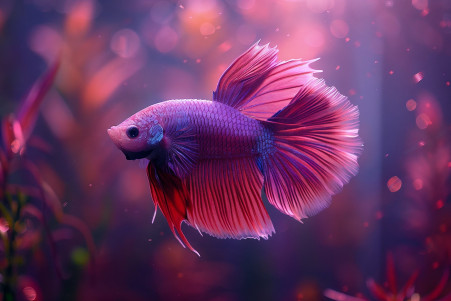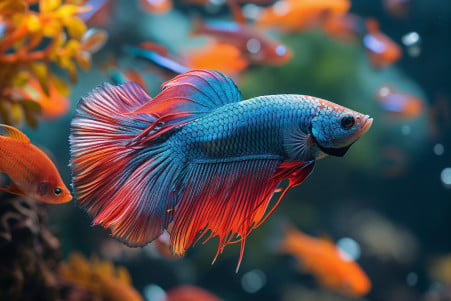Can Betta Fish See in the Dark? Exploring Their Low-Light Vision
9 June 2024 • Updated 8 June 2024

Light conditions can have a big impact on bettas' vision and behavior, but how well can these vibrant fish actually see in the dark? Betta fish have excellent night vision compared to many other fish due to the tapetum lucidum, a reflective layer in their eyes that enhances light absorption - allowing bettas to see fairly well even in very low light conditions.
This article will investigate the biology and evolution of bettas' ability to see in low-light conditions, drawing on research from ichthyologists and animal vision experts. This body of work explores the unique ocular anatomy of bettas and considers how their sensitivity to low light might be an asset in the wild. By learning about these nocturnal adaptations, betta owners can ensure that the tanks they set up for their fish are designed to support their pets' vision.
Can betta fish see in the dark?
The Tapetum Lucidum and Other Betta Fish Eye Structures
So, what makes bettas' vision so good in low-light conditions? It turns out that the answer lies in the special structures of their eyes. As ichthyologists have discovered, bettas have a reflective layer called the tapetum lucidum that increases light absorption, enabling them to see in the dark.
In addition, their eyes are tubular and their pupils are vertical, which helps them take in more light. Their eyes also have multiple lenses that help them focus light on their retinas, according to Betta Fish Center. These eye structures are well-suited for helping bettas see in the dark waters of their natural habitats.
That said, bettas' eyes aren't perfect. Their irises are slow to respond to changes in light, as Betta Buddy observes, which makes it hard for bettas to adapt to new light conditions. And because they have monocular vision, they don't have depth perception, which can make it hard for them to judge distances.
Still, bettas' eyes have evolved to help them see in the dark in some pretty amazing ways. Knowing this, it's possible to design tanks that take into account their unique eye structures and the way they see in the dark.
Evolutionary Adaptations for Low-Light Environments
Bettas have evolved a number of special adaptations that have enabled them to survive and thrive in the low-light, oxygen-poor, and acidic waters of their natural habitats. As the University of Florida explains, bettas are members of the labyrinth fish family, which evolved about 60 million years ago in response to hypoxic environments. The evolution of the labyrinth organ, a specialized respiratory structure, allows bettas to breathe atmospheric air at the water’s surface.
This adaptation to low dissolved oxygen levels has also influenced bettas' vision. As Betta Buddy points out, bettas are native to shallow ponds, rice paddies, and puddles with dense vegetation, low pH, and highly variable oxygen levels. The ability to see in low-light conditions in these environments is an important evolutionary adaptation.
Moreover, the same characteristics that have enabled bettas to survive in their small, confined habitats have also made them well-suited to aquaculture production, according to the University of Florida. Bettas' adaptations to shallow, vegetated waters have made them well-suited to the small tanks used in the global betta trade.
Navigating in the Dark: Betta Fish's Other Senses
In addition to their impressive ability to see in low light, betta fish also depend on other senses to move through their surroundings, especially when light is limited. According to PetMD, fish such as bettas have a "lateral line" system that acts as a sensory organ, detecting water movements and pressure changes that can help them locate objects and prey even when they can't see them.
Bettas' sense of smell and taste, which is collectively referred to as "chemoreception", is also important for finding food in low-light conditions. As explained on Fish Tankarium, bettas can probably detect changes in light and movement with their rod cells, but they use their chemical senses to find specific scents, such as the smell of shrimp pellets.
In addition, bettas use their sense of touch, especially through their pectoral "feeler" fins, to move through and interact with their environment, as mentioned in the Betta Fish Forum discussion. This allows them to avoid obstacles and maintain an understanding of their environment when their vision is limited by low light.
Behavioral Adaptations for Low-Light Environments
Bettas' ability to see in low light is inextricably linked to their natural behaviors and adaptations for life in dim, vegetated waters. For example, a study in PMC explains that bettas are well-known for their robust and stereotyped aggressive displays, which include males flaring their fins and erecting their gill covers when confronted with an opponent, even if it's their own reflection in a mirror.
Meanwhile, the same PMC study notes that betta fish also demonstrate complex parental behaviors, such as building bubble nests for their young and retrieving eggs or larvae that have fallen out of the nest. These behaviors, which have been honed through centuries of selective breeding, are well-adapted to the low-light environments in which bettas live. Fly Fish Finesse experts note that bettas use visual cues, such as fin flaring and color changes, to communicate with one another when light is scarce.
In addition, adding hiding places and live plants to a betta's tank can help recreate the dappled light of their natural environment, as pointed out by Aquarium QH. This doesn't just enable natural behaviors, it also gives bettas places to escape and sleep, which is important since constant light can disrupt their circadian rhythms.
How to Optimize Lighting for Betta Fish
As stated by Bettaboxx, betta fish can survive without a tank light, but they won't be happy in a dark or dim room. If you want to have live plants in your betta tank, you will need a light, as the plants need it to photosynthesize.
Betta Buddy points out that in the wild, bettas are used to natural, soft, and dappled light, which is created by the sun shining through the trees and plants that grow above the water. They also say that bettas like blue light that is similar to the color of the sky reflecting off the water in their natural environment.
However, it's also important to make sure that your betta has periods of darkness, as noted by Aquarium QH, which explains that if a betta is exposed to light for too long, it can interfere with their sleep and cause them to become stressed. To ensure that your betta has the right amount of light and darkness, you can use live plants, caves, and other decorations to create dappled light and give your betta places to hide and rest.
By setting up a betta tank so that the lighting is ideal for their low-light vision and their natural sleep/wake cycle, you can make sure that the environment you create for your betta meets their unique visual and behavioral needs.
Conclusion: Understanding and Supporting Bettas' Nocturnal Vision
Betta fish have evolved a number of special adaptations that enable them to see well in low-light conditions, including the unique structure of their eyes. Their tubular eyes, vertically-oriented pupils, and multiple lenses enable them to effectively absorb and focus light, even in the darkest of environments. Meanwhile, the tapetum lucidum, a reflective layer behind the retina, reflects light back through the retina, further enhancing their visual acuity.
These adaptations have evolved in response to the low-light, oxygen-poor, and acidic conditions of the betta's natural habitat. As a member of the labyrinth fish family, bettas have evolved a number of specialized respiratory and behavioral adaptations that enable them to survive in the shallow, vegetated waters they call home. Their ability to see well in these dim, dappled light environments is a key part of their evolutionary success.
Bettas also rely on their other senses, including their sense of smell, taste, and touch, to help them navigate their environment, especially when light levels are low. Their lateral line system enables them to detect water movements, while their chemoreception enables them to find food. Meanwhile, their pectoral fins are involved in tactile sensation and help them understand their surroundings.
Many of the behaviors that bettas exhibit in the wild, including aggressive displays and bubble nest building, are also adapted to low-light conditions. When keeping bettas in an aquarium, providing hiding places, live plants, and carefully controlled lighting can help replicate the dappled lighting of their natural environment and enable these behaviors.
By learning about the betta's remarkable low-light vision and the adaptations that make it possible, betta owners can create environments that meet their pets' unique visual needs and enable them to fully express their nocturnal behaviors.


